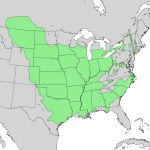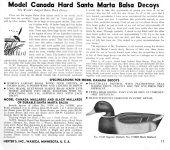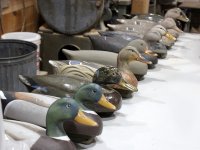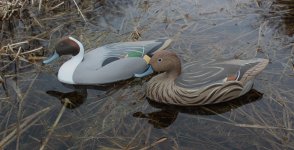jode hillman
Well-known member
Yes I think it is. When you say a quick with a southern drawl it kind of does sound that way! Lol and the more common name they use down chincoteague is Cottonwood.Isn't that what CIGAR called Baloney Wood?
Yes I think it is. When you say a quick with a southern drawl it kind of does sound that way! Lol and the more common name they use down chincoteague is Cottonwood.Isn't that what CIGAR called Baloney Wood?
So balsa and cottonwood are the same wood? I did not know that. Never used either one.Yes I think it is. When you say a quick with a southern drawl it kind of does sound that way! Lol and the more common name they use down chincoteague is Cottonwood.
If you're talking about the mid Atlantic area yes. If you're talking about the Cottonwood that grows in the Midwest noSo balsa and cottonwood are the same wood? I did not know that. Never used either one.
Yeah I was referring to what guys up the shore call cottonwood... paulonia (sp?). Had no idea that was balsa but like I said I've never used any of it.If you're talking about the mid Atlantic area yes. If you're talking about the Cottonwood that grows in the Midwest no
It is not balsa, it is slightly harder, and rot resistant, but it can be worked similar.Yeah I was referring to what guys up the shore call cottonwood... paulonia (sp?). Had no idea that was balsa but like I said I've never used any of it.
If you're talking about the mid Atlantic area yes. If you're talking about the Cottonwood that grows in the Midwest no
I'm confused..... but that ain't hard.It is not balsa, it is slightly harder, and rot resistant, but it can be worked similar.
It's a different tree than balsa, Empress Pailownia, but it's physical working property's are similarI'm confused..... but that ain't hard.
Who are you so wise in the ways of science?
Sorry, couldn't resist! Great explanation of the different species.
As an old fart with a BS in Wildlife Sciences, I can related!LOL...awesome Python reference.
I'm a guy with a BS in Forestry who had scientific names drilled into him 35 years ago.
I had to look up the scientific name for balsa, though...it wasn't a standard Southern tree species...I was surprised I remembered the ones I did, but they are SO unusual, they jumped out pretty quickly from the file in the brain. Ask me about blackjack oak versus black oak versus cow oak, and I'll be able to give you Quercus, but nothing after that.
But the above conversation also points out the weakness of "common names"....cottonwood versus cottonwood versus poplar...and the poplar isn't a poplar, but one of the cottonwoods is. And I thought Empress paulownia might be a variety of Royal paulownia, but it's another name for the same tree...
And for a third tangent, Grayson Chesser in his book used the term "baloney wood" to refer to foam decoys that were carved/shaped (not molded). What Cigar Daisey used the term for, I have zero clue....
As an old fart with a BS in Wildlife Sciences, I can related!
Common names, accepted common names and scientific names can sure get jumbled around regionally.
Have you seen how they finally split up ducks into different genuses based on genetics? We all knew bluewing teal were really shovelors (https://en.wikipedia.org/wiki/Spatula_(bird) ). And that gadwalls are really just wigeons in disguise (https://en.wikipedia.org/wiki/Mareca ). Lumpers and splitters, gotta love it.
Rick, Jode, Carl, Vince et al~Cottonwood on the East Coast is Paulownia tomentosa, Royal Paulownia. It's a non-native species - the seed pods were used as the first "packing peanuts" in shipments from China/Far East. When they were scattered out, they took root, and the local carvers used it...grew in fence lines, etc. and made decent decoys. Similar to catalpa.
There was a huge demand for American-grown Paulownia back in the 1980's or so, around the time the Japanese were buying premium walnut and other hardwoods. It was a staple in Japanese woodworking, and their stocks were limited. The forestry school I attended did some extensive research on paulownia plantations, thinking it would be an international forestry product, but the plantation grown wood didn't have the same characteristics or grade as "naturally grown", so with no demand, it was abandoned. Of course, I didn't know about its use for decoys back then, or I would've asked the professors if I could have cut the paulownia and used it...
Cottonwood in the southeast and midwest is Populus deltoides. The wood is stringier and heavier than Paulownia, prone to check and separate as it dries. Same genus as quaking aspen.
Yellow-poplar or tulip poplar that you get planks from at Home Depot, etc. is Liriodendron tulipifera, but not a "true" poplar. Several carvers in the midwest used to use it for heads...think Joe Wooster did some back in the 1970's, most notably. Big thing now with yellow poplar is getting it in usable thicknesses.
Balsa is Central/South American, Ochroma pyramidale.






Carl~As an old fart with a BS in Wildlife Sciences, I can related!
Common names, accepted common names and scientific names can sure get jumbled around regionally.
Have you seen how they finally split up ducks into different genuses based on genetics? We all knew bluewing teal were really shovelors (https://en.wikipedia.org/wiki/Spatula_(bird) ). And that gadwalls are really just wigeons in disguise (https://en.wikipedia.org/wiki/Mareca ). Lumpers and splitters, gotta love it.
Rick, you hit the nail on the head as far as Polonia being expensive and hard to get in the 80s and 90s.LOL...awesome Python reference.
I'm a guy with a BS in Forestry who had scientific names drilled into him 35 years ago.
I had to look up the scientific name for balsa, though...it wasn't a standard Southern tree species...I was surprised I remembered the ones I did, but they are SO unusual, they jumped out pretty quickly from the file in the brain. Ask me about blackjack oak versus black oak versus cow oak, and I'll be able to give you Quercus, but nothing after that.
But the above conversation also points out the weakness of "common names"....cottonwood versus cottonwood versus poplar...and the poplar isn't a poplar, but one of the cottonwoods is. And I thought Empress paulownia might be a variety of Royal paulownia, but it's another name for the same tree...
And for a third tangent, Grayson Chesser in his book used the term "baloney wood" to refer to foam decoys that were carved/shaped (not molded). What Cigar Daisey used the term for, I have zero clue....
I’ve had tupelo (Nyssa aquatica) ripple on me like that. For as amazing as it can be, sometimes it gets some oddball grain and/or a big difference in the hardness of the growth rings.Rick, you hit the nail on the head as far as Polonia being expensive and hard to get in the 80s and 90s.
I answered a want ad in the local paper to buy a bunch of white cedar from a Carver of totem poles who was retiring due to advanced age.
I bought a beautiful truckload of white cedar but before I left he said "take some of these boards, they're hard to get but you will love them." "Don't come looking for Anymore, Because you can't get it at least without a truck full of money"
He gave me 6 beautiful woods grown empress paulownia boards. I was hesitant and even skeptical at first. But I made a rig of solid Wigeon that I hunted for eight years. They rode the water beautifully, resisted rot and decay and held paint well. I was sold. Alas he was right, I could not locate any more for less than $20 a board foot.
Fast forward to the early 2000s, China opened up its trade and began to supply the Japanese Polonia market. This left a glut of Polonia in the mid Atlantic and that was not good for firewood and shipping costs prevented it from being sent overseas now due to the closer Chinese supply.
If you ask around your local tree surgeons and services they will know what it is. It can often be had for very reasonable prices. It drys well and it has no pitch or sap to contend with. If you quarter saw and have vertical growth rings you will not find a better Decoy wood anywhere.
The only downside is there tends to be a difference in hardness between the growth rings, so you must sand it to 100 grit and no finer otherwise it will look ripply(. Similar to white pine that is sanded to fine)
Wooden surfboard makers have taken to it as well. It holds up wonderfully in the harsh saltwater environment where they ply their trade.
Just another 2 cents to the discussion
Steve,Rick, Jode, Carl, Vince et al~
As a New Yorker I have to jump in here....very interesting thread!
What we call Cottonwood is in fact Eastern Cottonwood (Populus deltoides) and is native. We even get the window screens full of its "cotton" when it is sending its seeds afar. My father-in-law was a logger in northern New York. His common name for it was Balm O'Gilead (pronounced bommagillerd...but a different Populus altogether). What I did not know was that Eastern Cottonwood has limited distribution within our state. It is common, though, in places I have lived - including the Hudson Valley right up through the Champlain Valley and on the Lake Plains of Western NY. I did not know it was absent from Jode's stomping ground - and most of the mid-Atlantic. And, I did not know that the name was aplied to other carving woods.
View attachment 58089
I know Royal Paulownia as Princess Tree. It is uncommon in the wild up here - and is native to China.
Having said, that I have not carved any of these "soft hardwoods" - Paulownia, Catalpa, Populus, et cetera. I have made a couple from Balsa (the South American wood) and I grew up with Herter's Hard Santa Marta Model Canada decoys -
View attachment 58092
- as well as Wildfowler Superior Model birds.
View attachment 58094
In recent years, I have been assembling gunning rigs of each.
Here are the Herters - in process.
View attachment 58090
I will be bringing 10 or so Wildfowlers to Tuckerton in a couple of weeks to show along with my sneakbox JAMES CAIRD.
View attachment 58091
These Pintails were hard to find - at least at the prices I have been willing to pay.
View attachment 58093
I'm a Wildlife Sciences guy - Cornell Class of '75. One of most important things I learned there came from a guest lecturer - Dr. Bill Hamilton, retired Mammalogy professor. He told my fellow freshman: "If you don' know plants, you cannot call yourself a wildlife biologist". Those words set me on a lifetime of learning - which is still on-going, thanks to gents like you.
All the best,
SJS
